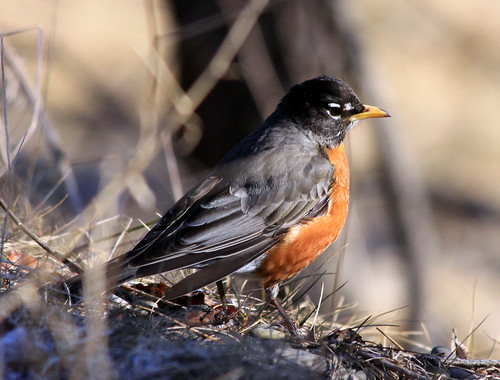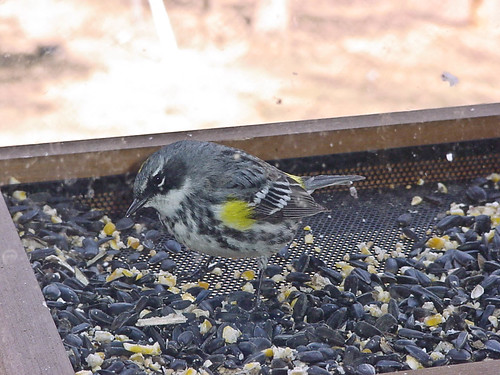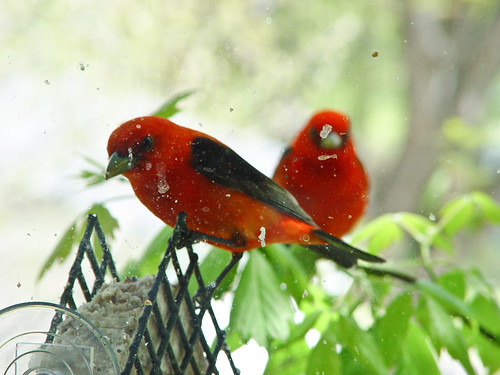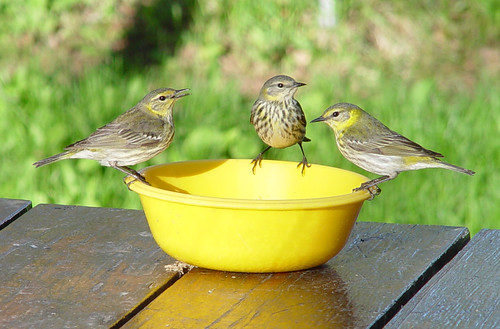Back in 1982, Russ and I left Duluth for Arizona at the end of March and didn’t return home until April 17. When we left, we had lots of redpolls at our feeder, and there was lots of snow on the ground, so I paid a local boy to keep my bird feeders filled each day, telling him he could stop after the snow melted and the redpolls disappeared. But when we got home, the snow was deeper and there were even more redpolls visiting our yard than when we’d left.
There’s a reason April Fools Day is set in April. The problem is that many of our migrating birds are playing games of probability, partly driven by genetics. If the first robins of spring happen to be early birds in a year when spring arrives early, they do indeed get the worms, along with top-notch territories and a jump on the more cautious or lackadaisical robins, and that year a bumper crop of baby robins will carry the antsy early bird genes. But in years like this, when there are no worms available for the early birds, the earlier robins end up hungry as late winter fruit supplies grow badly depleted and worms are securely buried under frozen topsoil and inches of snow.
I’ve received a few emails about robins visiting suet feeders, and I expect that when they wend their way up here, Yellow-rumped Warblers will be visiting feeders as well.
There is always mortality during spring migration—whenever birds leave there are perils galore, including collisions with windows and lighted towers, predation, habitat destruction and loss, and all manner of other hazards before we even start considering the weather. Songbirds are tiny mites, many weighing significantly less than an ounce, yet they power their way through hundreds or thousands of miles without benefit of GPS, restaurants, hotels, or any of the other amenities we mere humans consider necessities on a trip. And whatever the weather, they make this journey naked as jaybirds.
Storms can kill a lot of birds, especially tornadoes and ice storms. Deaths from this kind of extended cold aren’t nearly as dramatic but are still significant. In 2004, after what seemed like an early spring in April, we had a crushing cold snap in May, after a great many of the insectivores that winter in the tropics had arrived. Scarlet Tanagers and Cape May Warblers became regulars at some fruit and sugar water feeders alongside Baltimore Orioles.
My own feeders certainly helped the dozens of birds that discovered them, but I hated thinking about the countless birds that never did find a feeding station. There’s a lot of controversy involved in providing jelly for birds, but that particular year, jelly feeders kept a lot of birds alive until spring finally arrived.
This year is shaping up to be a seriously bad one. This morning the Raptor Education Group of Antigo issues a Bird Emergency Alert. Marge Gibson posted:
Last night, into early morning, I took over fifty phone calls, texts and Facebook messages. Most were about weak and dying warblers, robins and woodcocks. Please understand this is an extraordinary situation. More snow and cold temperatures are predicted for Wednesday and Thursday. The birds require your help. YOU CAN MAKE A DIFFERENCE!
This is not a normal spring. The birds can deal with some snow and cold, but not deep snow (30 plus inches) and sustained cold. They have slipped into hypothermia, unable to maintain their own body temperature or keep themselves warm any longer. Birds that eat insects cannot find natural food. They are starving.
If you see a bird that you can pick up, PLEASE do so. Put it in a cardboard box, not a cage or a carrier. Put a towel in the bottom of the box and bring them into a warm area. Put a heating pad on low under part of the box. Cover the box to create an "incubator" of sorts. You are looking for a temperature of about 80 degrees. Put food in the box. Live or dried mealworms and live waxworms work. (obtain from Wildbirds Unlimited ,Gas station/Fleet Farm/Walmart anywhere that sells fishing bait) Keep bird/box away from family pets. Transport the bird as soon as you can to our facility or your local avian wildlife rehabilitation center.
If you cannot transport the bird, we will try to find a volunteer transporter. If weather again becomes hazardous call for more instructions. Keep the bird warm, well fed, a small non-tip dish of water in the box in the meantime. Do not release while weather conditions remain challenging.
AGAIN: Please keep your bird feeders full. Robins can eat cut-up raisins, dried mealworms, shelled sunflower-seed pieces, frozen blueberries, crumbled suet blocks. Put food on the ground where you see the birds. Robins congregate along rural roads, near stands of pine,spruce or other conifers. You can also feed them in those locations, Make sure the food you put down is off the roadway. If you see a bird in need, PLEASE pick it up and put it in cardboard box with a towel in the bottom. Bring it into a warmed area. Birds are dying of malnutrition and hypothermia and need assistance to get through this horrific weather. Call REGI at 715-623-4015 or your local avian rehabilitator for guidance. We continue to operate without full staff due to weather conditions.
Thank you for your help. We are in desperate need of volunteer drivers for this event specifically. Please call 715-623-4015 or leave a message on Facebook if you can help us. Birds are coming from Marshfield, Stevens Point, Pittsville, Adams Friendship, Wausau, Shawano, Marion and all of the surrounding areas.



